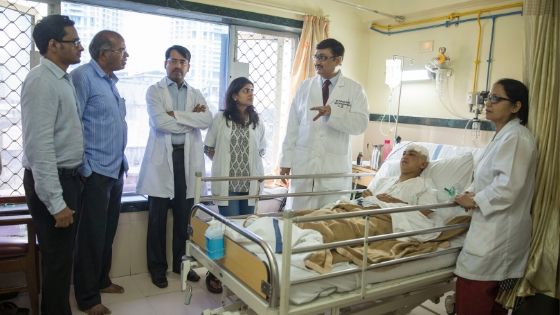Approximately 10 to 12 days of hospitalisation of the patient is needed for Deep Brain Stimulation surgery. History & neurological examination of the patient is done on admission by a resident doctor.
Any morbid medical conditions such as heart disease, Hypertension and diabetes etc. have to be ruled out & the patients are advised to disclose about any such illness for better evaluation prior to the surgery.
Routine investigations such as blood test, ECG, 2D Echo, X-Ray of chest as well as pre anaesthetic check-up are also carried out on the patient prior to the surgery.
The patient has to undergo Unified Parkinson’s Disease Rating Scale (UPDRS) examination in OFF and ON medications for evaluation of the severity of Parkinson’s disease.
Mini-mental status examination (MMSE)to evaluate memory & judgement issues. For OFF phase UPDRS examination, all anti Parkinson’s medications are stopped at around 9pm on the day of admission as almost 12 hrs are required to ward off the effects of anti-parkinsonian drugs.
For ON phase evaluation, the patient is given 2 times his usual dose of L-dopa and the UPDRS is repeated. Video recording of patient’s motor activity is done in both OFF & ON phase.
Patient’s caretakers are supplied with Parkinson’s Disease Questionnaire 39 Items (Global QoL) and Zerith Caretaker Burden Inventory (ZCBI) which has to be filled by them.
Pre-operative 3 Tesla Magnetic Resonance Image (MRI) of the brain is done in DBS protocol that serves as a roadmap during DBS surgery for Parkinson’s disease by the neurosurgeon to ensure proper placement of electrodes.
Parkinson’s disease nurse helps in promoting a relaxed and supportive environment in pre-operative waiting period as well as during surgery. Patient cooperation and comfort during the DBS surgery is highly essential & patients are encouraged to express their needs so as ensure a relaxed ambience.
PD nurse spends considerable time explaining the surgical procedures with the patient and their relatives to relieve their anxiety. Repeated interaction with the patient boosts confidence in him regarding surgery.
Sometimes this conversation with the patient brings out important observations by the PD nurse that helps the surgeon & his surgical team conducting a safe and smooth surgery on the patient.
Personalized care from a well-informed team of nurses & paramedics within the ward allow the patients to gain confidence over the caretakers during the stay in the hospital.
The pre-op preparation starts with pre-anaesthetic check up on the 2nd day evening by the anesthesiologist who thoroughly evaluate patient’s medical fitness prior to surgery.
This is followed by head shaving, after obtaining due consent. Consent for surgery should also be obtained from the patients and their spouse or close relatives. Anti-Parkinson’s medications are stopped around 10 pm & the patient should be kept in empty stomach.
At around 4 A.M. patient is given a banana and a glass of milk or a chocolate to prevent vasovagal syncope during surgery.
Patient should be bathed properly and kept ready at 6 A.M. to be shifted to operation theatre for surgery. Once everything is ready, the resident doctor shifts the patient to Operation theater at around 7.30 A.M.
The OT staffs begin preparation for surgery that includes insertion of an IV canula, administration of antibiotics & IV fluids as well as monitoring of the patient’s vital signs like Blood pressure & pulse. Urinary catheter is inserted by the resident doctor after shifting the patient to OT table.
The duration of entire surgical process is around 5 to 6 hours. The placement of stereotactic frame is done under local anaesthesia. It consists of ahead ring which is attached at 4 points (two anteriorly & two posteriorly) to the patient’s skull.
The placement of the frame is done under monitored anaesthesia care under direct supervision of an anaesthesiologist with minimal sedation, to ensure patient comfort.
The procedure is done under local anaesthesia & the patient remains awake throughout the surgical procedure. Surgery starts with drilling of burr holes on the top of the skull at desired points predefined by functional planning.
As both bone & brain are insensitive to pain, this surgery becomes a relatively painless procedure by infiltration of local anaesthesia into the scalp. After burr holes are made, thin microelectrodes are inserted into the predefined targets deep inside the brain & physiological brain mapping is done by a procedure called micro-electrode recordings.
Once the exact location is identified by MER, a low voltage current (micro stimulation) is administered through the macroelectrodes to find out the level of improvement that can be achieved by DBS.
This is followed by checking of side effects by increasing the micro stimulation. Patient’s cooperation is highly necessary at this stage.
The level of improvement is judged by arrest of tremors in patients experiencing tremors, relief from pain in patients presenting with pain and there will be decrease in stiffness in patients presenting with Parkinson’s disease on stimulating the correct target site.
Permanent DBS lead is implanted under fluoroscopic guidance once adequate confirmation of the target site is obtained by the surgical team though MER mapping & response to micro stimulation.




